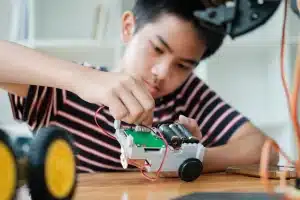How Building Robots as Toys Inspires STEM Education
In recent years, there has been a growing interest in integrating STEM (Science, Technology, Engineering, and Mathematics) education into schools and educational programs around the world. One innovative approach to engaging students in these subjects is by building robots as toys. By combining the excitement of technology with the hands-on experience of constructing and programming robots, children and young adults can develop essential skills that will benefit them in their future education and career paths.
Features of Robot Building Toys:
- Intuitive Building Process: Robot building toys typically come with step-by-step instructions that allow children to construct their robots in a logical and intuitive manner. These instructions help develop problem-solving skills and spatial awareness.
- Diverse Range of Robots: Whether it’s a humanoid robot, a rover, or a drone, robot building toys offer a diverse range of options. This diversity allows students to explore different areas of robotics and identify their specific interests.
- Customizable and Modular Designs: Many robot building toys have modular designs, allowing students to modify and customize their robots according to their preferences. This encourages creativity and empowers learners to think outside the box.
- STEM-Focused Components: Robot building toys are equipped with various STEM-focused components such as sensors, motors, microcontrollers, and more. These components expose students to the basics of robotics and engineering concepts.
- Integration of Programming: To bring their robots to life, children are often required to program them using accessible software interfaces. This introduces students to the fundamentals of coding and computational thinking.
- Team Collaboration Opportunities: Building robots as toys can also foster teamwork and collaboration among students. Many robot kits are designed to be assembled and programmed jointly, promoting cooperative problem-solving and communication skills.
Inspiring STEM Education:
Now that we have explored the features of robot building toys, let’s delve into how they inspire STEM education:
- Hands-On Learning: Building robots as toys provides students with a unique hands-on learning experience. It allows them to apply concepts learned in the classroom to real-world scenarios, enhancing their understanding and retention of STEM principles.
- Motivation and Engagement: The interactive and creative nature of building robots captures the interest and curiosity of students. This motivation and engagement lead to increased interest in STEM subjects and encourage students to pursue further education or careers in these fields.
- Problem-Solving Skills: Building robots requires critical thinking and problem-solving skills. As students encounter challenges during the construction and programming process, they learn to analyze problems and find innovative solutions – a skill set that extends beyond robotics into various aspects of life.
- Logical Thinking: The logical flow of building and programming robots helps students develop logical thinking abilities. They learn to break down complex tasks into smaller, more manageable steps, enhancing their ability to approach challenges systematically.
- Creativity and Innovation: Robot building toys foster creativity and innovation by encouraging students to think creatively and explore new ideas. The customizable nature of these toys allows students to experiment and find unique solutions to problems.
- Career Exploration: Building robots as toys can ignite an early interest in STEM careers. Through hands-on experiences, students gain insight into the types of careers available in robotics, engineering, and technology, helping them make informed decisions about their future career paths.
In conclusion, building robots as toys serves as a powerful tool to inspire STEM education. The combination of hands-on learning, problem-solving skills, logical thinking, and creativity makes it an ideal platform to engage students in science, technology, engineering, and mathematics. By integrating robotics into educational settings, we can create a generation of young minds empowered to tackle the challenges of the future.





